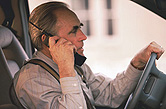
TUESDAY, Sept. 28 (HealthDay News) — New research from the University of Utah suggests that a touch-based navigation system embedded in a car’s steering wheel and designed to interact with the skin of a driver’s fingertips can be an effective way to deliver GPS-style directions.
Such a skin-contact system may prove to be a less distracting and safer way to deliver directions than a voice-activated system, the study authors say.
First author Nate Medeiros-Ward, a University of Utah psychology doctoral student, was scheduled to present the team’s observations on Tuesday at the Human Factors and Ergonomics Society meeting in San Francisco.
Lead author William Provancher, an assistant professor of mechanical engineering at the university, said in a school news release that “our sense of touch is currently an unexplored means of communication in the car.” A touch-based system, he said, “has the potential of being a safer way of doing what’s already being done — delivering information that people are already getting with in-car GPS navigation systems.”
In this experimental system, two red buttons are inserted on the steering wheel so they are in contact with the index fingertips of each hand. When instructing the driver to turn left, the buttons subtly push the skin of each fingertip left; when indicating right, the skin is pushed right.
The authors tested their touch-based navigational device employing a driving simulator that has been used to demonstrate the dangers of driving while texting or talking on a cell phone. Nineteen undergraduates sat in the drivers’ seats surrounded by screens displaying images of traffic on three sides, in a setting that simulated driving down the center lane of a three-lane freeway.
The research team found that in the absence of cell phone use, both the traditional voice-navigation system and the touch-based system worked equally well — namely, about 97 percent of the time.
But when drivers were instructed to talk on their cell phones, the touch-based system actually worked better: 98 percent of the time, versus just 74 percent of the time with a voice-based system.
“You can’t look at two things at the same time,” explained co-author and psychology professor David Strayer in the news release. “You can’t look at graphic display of where you should go and look out the windshield. [Touch-based information] is a nicer way to communicate with the driver without interfering with the basic information they typically need to drive safely.”
The authors noted that drivers already unconsciously respond to touch-based feedback all the time, such as when they gear-shift or feel tire problems in the shaking of the steering wheel. They cautioned, however, that such a system should not be a cue to multitask.
“We are not saying people should drive and talk on a cell phone and that tactile [touch] navigation cues will keep you out of trouble,” Medeiros-Ward said.
The researchers are already in discussions to see whether a specialized walking cane outfitted with a similar touch-based device might ultimately assist the blind community. Hearing-impaired people might also benefit from the technology, they added.
The current technology was funded by both the University of Utah and the National Science Foundation.
More information
For more on safety concerns about driving while distracted, visit the National Highway Traffic Safety Administration.

